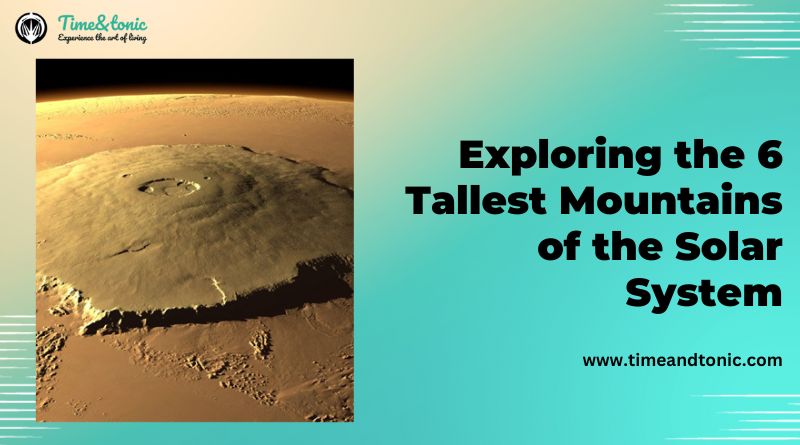Exploring the 6 Tallest Mountains of the Solar System
When our thoughts drift toward towering mountains, it’s almost instinctual to conjure images of Earth’s most iconic peaks, such as the mighty Himalayas or the breathtaking Andes. Yet, in the vast expanse of our solar system, a cosmic gallery of monumental mountains awaits our discovery—giants that would make our terrestrial summits appear diminutive by comparison. In this captivating article, we’re set to embark on an extraordinary voyage, one that transcends earthly boundaries, as we venture into the cosmos to unveil the awe-inspiring splendor of the six tallest mountains our celestial neighborhood has to offer.
These monumental peaks, etched into the cosmic tapestry, are not bound by earthly constraints. They rise above their planetary homes with an air of grandeur, each possessing a unique charm and an astronomical story waiting to be told. Together, we’ll traverse the reaches of our solar system to scale these celestial summits, uncovering the mysteries they hold and gaining a newfound appreciation for the boundless wonders of the universe. So, fasten your cosmic seatbelts, dear readers, as we ascend to new heights, leaving Earth far behind and ascending to the very pinnacles of our celestial neighbors’ majestic mountains.
6 Tallest Mountains of the Solar System
Olympus Mons (Mars)

Height: Approximately 13.6 miles (21.9 kilometers)
Our journey begins on the Red Planet, Mars, where we encounter Olympus Mons. This colossal volcano is not only the tallest known volcano but also the tallest mountain in the entire solar system. Standing at about 13.6 miles (21.9 kilometers) high, Olympus Mons is a towering giant, nearly three times the height of Mount Everest, Earth’s tallest mountain. The enormity of Olympus Mons is a testament to the geological wonders that await us in the cosmos.
Rheasilvia (Vesta)

Height: Estimated to be around 14 miles (22.5 kilometers)
Next, we venture to the asteroid Vesta, where we find the central peak of the Rheasilvia impact basin. This imposing peak reaches an estimated height of around 14 miles (22.5 kilometers). The impact that formed this basin and its central peak left an indelible mark on Vesta’s surface and gives us a glimpse into the violent history of our solar system.
Also Read:- Cost-effective Backpacking Treks
Maxwell Montes (Venus)

Height: Approximately 7 miles (11 kilometers) above the planet’s average surface elevation
Our cosmic journey now takes us to Venus, the second planet from the sun. Here, we encounter the Maxwell Montes, the highest mountain range on Venus. Rising to approximately 7 miles (11 kilometers) above the planet’s average surface elevation, Maxwell Montes is a formidable geological feature on a planet known for its extreme conditions. The stark contrast between Earth’s serene beauty and Venus’s harsh environment is a reminder of the incredible diversity within our solar system.
Tartarus Montes (Mars)

Height: Tallest peak reaches around 8.7 miles (14 kilometers)
Returning to Mars, we explore the Tartarus Montes, a grouping of three shield volcanoes located near the Martian equator. The tallest peak among them reaches an impressive height of around 8.7 miles (14 kilometers). The presence of such massive volcanic structures on Mars offers valuable insights into the planet’s geological history and the forces that have shaped its surface over eons.
Maat Mons

Height: 29,000 feet (8.9 kilometers)
Maat Mons is a prominent geological feature on the surface of Venus, often referred to as a “shield volcano.” It holds the distinction of being the tallest volcano on Venus and is one of the most notable volcanic structures in the solar system. This imposing mountain rises to an impressive elevation of about 29,000 feet (8.9 kilometers), making it significantly taller than most mountains found on Earth.
Boösaule Montes (Io)

Height: Peaks reaching heights of about 6.8 miles (11 kilometers) above its surface
Our final destination on this cosmic tour is Io, one of Jupiter’s intriguing moons. Io features the Boösaule Montes range, where peaks soar to heights of about 6.8 miles (11 kilometers) above its surface. Io’s unique landscape, characterized by volcanic activity and colorful sulfur deposits, is a stark contrast to the serene beauty of our home planet.
Conclusion
In conclusion, as we stand in awe of the towering giants that grace our solar system’s celestial landscapes, we are granted a profound glimpse into the astonishing diversity and wonders that extend far beyond the familiar boundaries of Earth. These monumental geological formations, ranging from the mighty Olympus Mons on the rusty plains of Mars to the otherworldly terrains of distant moons like Io, serve as luminous beacons illuminating the vast tapestry of our cosmic neighborhood.
Our exploration of these magnificent mountains has not only expanded our horizons but also deepened our appreciation for the sheer grandeur and intricacy of the universe. They are testaments to the ceaseless forces of nature, sculptors of awe-inspiring vistas that challenge our understanding and ignite our curiosity.
FAQs
Olympus Mons, which is on Mars, is the tallest mountain in the whole solar system. It stands at an astounding height of approximately 69,841 feet (21.287 kilometers), making it nearly three times the height of Mount Everest.
Currently, human exploration of these celestial mountains remains a challenging endeavor. However, space agencies like NASA and private companies are actively working on plans for future manned missions to Mars and beyond, which could include exploration of these extraterrestrial peaks.




